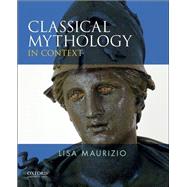Classical Mythology in Context encourages students to directly encounter and explore ancient myths and to understand them in broader interpretative contexts. Featuring a modular structure that coincides with the four main components of a classical mythology course--history, theory, comparison, and reception--each chapter (with the exception of Chapter 1) is built around one central figure or topic.
Classical Mythology in Context provides:
A sustained discussion of religious practices and sacred places that offers a key approach to the historical contextualization of Greek myths
An introduction to--and integration of--theoretical approaches to myth in each chapter that shows how these approaches affect the ways in which students understand myths and mythic figures
Ample selections of primary sources, all from the Oxford World's Classics series
A robust comparative approach examining Greek myths alongside other myths from the Mediterranean Basin and the Ancient Near East
An approach to the reception of myths as interpretation and reflection in Western art, with an emphasis on contemporary culture
An Ancillary Resource Center (ARC) that includes PowerPoint-based lecture slides and an Instructor's Resource Manual
A Companion Website that provides additional student and instructor resources
FEATURES
Compelling and relevant illustrations provide visual evidence for placing myths in context
Abundant maps help students locate all sites in Greece, the larger Greek world, and the Ancient Near East
A detailed Timeline for Greece, Rome, and the Ancient Near East helps students situate key works within their cultural and historical contexts
"The Essentials": In Part I, these boxes appear at the start of each chapter, introducing students to the most essential information about a god or goddess and previewing that chapter's content. In Part II, they appear whenever a new hero or heroine is introduced.
"Before You Read" section for each primary source and critical reading is prefaced with a brief contextual overview followed by questions that encourage critical thinking
Paired chapters explore different aspects of a god, hero, or heroine, equipping students with analytical tools that can be applied to other topics
A list of Key Terms at the end of each chapter helps students review and retain its most important points
A "For Further Exploration" annotated bibliography at the end of each chapter provides a starting point for students who wish to learn more about the chapter's content
A Select Bibliography at the end of the book, divided by chapter (and further divided by chapter section) emphasizes scholarly works that are accessible to students
A Combined Glossary and Index includes a pronunciation key, the Greek form (where relevant), and brief description for all figures, places, and rituals in the text








